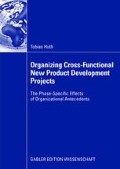Abstract
Duncan’s (1976) and Souder & Moenaert’s (1992) theories are based on distinguishing between mechanistic and organic organization designs. Moreover the theoretical framework of this investigation, requires an understanding of the specific stages of the innovation process and their characteristics. Therefore, Burns & Stalker’s (1961) concept of organic and mechanistic organizations (3.1) will be discussed initially. It is followed by a presentation of the innovation process and its stages (3.2) and a discussion of the stage specific (and uncertaintyrelated) information processing requirements of the innovation process representing important characteristics (3.3). As indicated, the theoretical fundament for the phase-specific effectiveness of organic and mechanistic structures relies on Duncan’s (1976) concept of the ambidextrous organization, and on the closely related information uncertainty reduction model proposed by Souder & Moenaert (1992) (3.4). The theoretical fundament related to the phasespecific effectiveness of boundary spanning activities relies on resource dependency theory (Pfeffer 1982, Pfeffer & Salancik 1978) (3.5).
Access this chapter
Tax calculation will be finalised at checkout
Purchases are for personal use only
Preview
Unable to display preview. Download preview PDF.
References
Naveh (2005, p. 2794) notes that “innovation needs to be emphasized in the early stages so that teams seeking new ideas are galvanized, and in the later stages it is efficiency that has to be emphasized, enabling routine orientation in order to successfully complete the project.”
Uncertainty is defined as the difference between the amount of information required to perform a particular task and the amount of information already possessed by an organization (Souder & Moenaert 1992, p. 487, Galbraith, 1973). Uncertainty consists of two main elements: “The variability of a task”, which refers to the amount and variation by which uncertainty emerges, and “the analysability of a task” referring to extent to which there are known procedures to identify uncertainty and reduce it.
In contrast to Duncan (1976), Souder & Moenaert (1992) also argue that the intensity of the switch should depend on how efficient the uncertainty reduction during the planning stage has been. A high level of formalization (centralization) will only contribute to the success of the development stage, if the initial uncertainty reduction has been efficient. If there remains uncertainty during the development stage, the authors propose that medium levels of formalization (centralization) are more effective.
For instance, conflicts may occur due to an increased need for cross-functionality in the initiation stage or due to the reduction of authority in the implementation stage. Interpersonal relations between functions have to be fostered, because these functions are required to work together more intensively. Finally, top management’s role is to institutionalize, communicate, and stand up for the dual structure in order for it to become accepted in the organization (Duncan 1976, p. 185).
Even though it could be argued that creativity is essential throughout the entire innovation process, the general requirements for creativity are higher at the early project stage (Souder & Moenaert 1992, West 2002, p. 358). Hence, at the outset, creativity dominates, but it is superseded later by the innovation implementation process (West 2002, p. 356). Yet, it serves to assess the relevance of creativity and efficiency for other dimensions of product development performance.
For a different view, cp. Naveh (2005, p. 2794), stating that efficiency is mostly relevant during the late project stage.
Quality is reflected in product dimensions such as appearance, performance, workmanship, and life/durability (Aaker & Jacobson 1994, Clark & Fujimoto 1991, Garvin 1988, Jacobson & Aaker 1987, Philips et al. 1983, Sethi 2000, p. 1).
There is also some empirical support for the beneficial effects for organic structures to boost efficiency, and at the same time, for mechanistic structures to impede efficiency. For instance, Lewis et al. (2002, p. 559, 562) find that participative management helps to increase a team’s schedule adherence, while formal reviews negatively impact within budget adherence. Eisenhardt & Tabrizi (1995, p. 84) find that an experimental product development strategy that relies on improvisation, frequent iteration, and flexibility accelerates product development, while planning and rewarding for schedule are ineffective ways of accelerating pace.
In contrast, informal controls are unwritten and typically worker-initiated mechanisms that influence the behavior of individuals or groups (Jaworski 1988, p. 26–27).
This dilemma is indicated by the study of Sarin & Mahajan (2001). The authors demonstrate a negative relationship between performance and process-based rewards for highly complex projects, and also a negative relationship between product quality and outcome based rewards for projects exhibiting a high level of risk.
For a contrary position, where milestones are assumed to have a positive effect in uncertain situation, cp. Eisenhard & Tabrizi (1995).
In addition, previous research provides strong evidence that boundary-spanning activities in general, or particularly the integration with functional departments and top management support are positively associated with team efficiency, creativity, and overall team performance (Ancona & Caldwell, 1992b, Hoegl & Weinkauf 2005, Keller 2001, McDonough 2000, Millson & Wilemon 2002, Sethi et al. 2001, Shalley & Gillson 2004, Swink 2000, Tierney et al. 1999).
See Stock (2006, p. 591) for another example where similar control variables are included when team performance is the dependent variable.
See Stock (2006, p. 591) for another example, where similar control variables are included, when team performance is the dependent variable.
Rights and permissions
Copyright information
© 2008 Betriebswirtschaftlicher Verlag Dr. Th. Gabler | GWV Fachverlage GmbH, Wiesbaden
About this chapter
Cite this chapter
(2008). Theoretical Framework for the Phase-specific Effects of Organizational Antecedents in Cross-Functional New Product Development. In: Organizing Cross-Functional New Product Development Projects. Gabler. https://doi.org/10.1007/978-3-8349-9642-8_3
Download citation
DOI: https://doi.org/10.1007/978-3-8349-9642-8_3
Publisher Name: Gabler
Print ISBN: 978-3-8350-0926-4
Online ISBN: 978-3-8349-9642-8
eBook Packages: Business and EconomicsBusiness and Management (R0)

